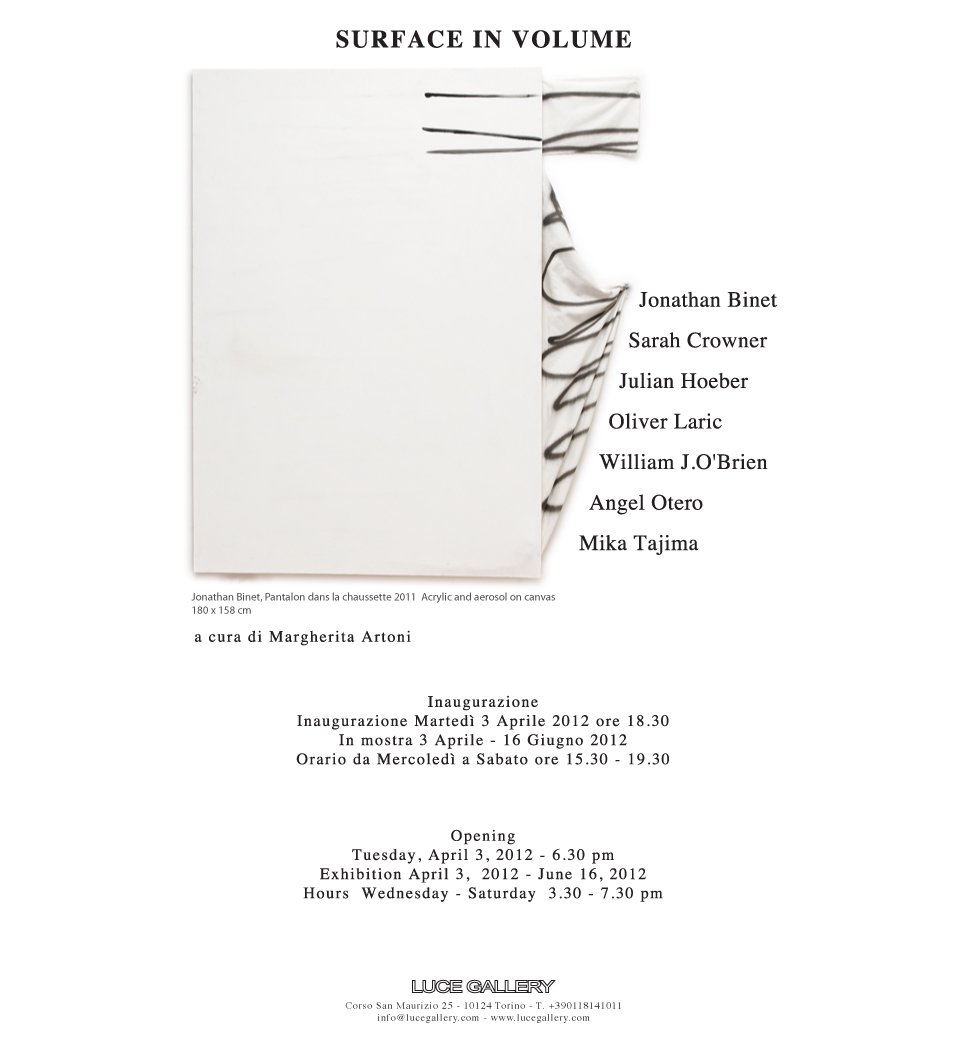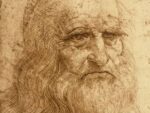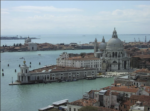Surface in volume

La mostra si propone di scandagliare la componente scultorea del medium pittorico mettendo radicalmente in questione la tradizionale raison d’être dell’arte a due dimensioni, senza tuttavia escludere la possibilità di un’inedita e più complessa coerenza stilistica.
Comunicato stampa
Luce Gallery è lieta di ospitare la nuova produzione artistica di sette giovani e influenti protagonisti del dipinto contemporaneo. La mostra collettiva, a cura di Margherita Artoni, si propone di scandagliare la componente scultorea del medium pittorico mettendo radicalmente in questione la tradizionale raison d'être dell'arte a due dimensioni, senza tuttavia escludere la possibilità di un'inedita e più complessa coerenza stilistica. L'ipotesi tridimensionale del dipinto viene esplorata dagli artisti con materiali alternativi, tecniche d'avanguardia, insolite geometrie, trasparenze e giustapposizioni cromatiche al fine di inaugurare un linguaggio dall'impronta marcatamente provvisoria attraverso cui la superficie pittorica rompe il margine che la disgiunge dalla scultura occupando un territorio ibrido e proprio per questo così affascinante. Non si tratta dunque di una mera sperimentazione manierista portata all'estremo, ma di una necessità consapevole e latente al tempo stesso che obbliga il pensiero dell'autore a cercare nel filtro gnoseologico del dipinto un'inesauribile strumento di prassi creativa.
Jonathan Binet sovverte la concezione classica dell'opera su tela maturando un'indagine approfondita intorno alle componenti performative del puro processo pittorico, ricondotto al "grado zero" grazie ad importanti accorgimenti tecnici tra cui l'uso iterato dello spray. Nel corpo di lavoro dell'artista francese il gioco oppositivo tra intenzione e caso sposa la centralità instabile del movimento dando vita ad una vera e propria poetica del gesto che suggerisce, di riflesso, un incontro paradossalmente equilibrato tra la sfera temporale del ritmo e quella spaziale del dipinto.
Jonathan Binet è nato nel 1984 a Saint-Priest, vive e lavora a Parigi. Mostre selezionate: Gaudel de Stampa (Paris), Treize (Paris), Galeries d'exposition Beaux-Arts (Paris), Chert (Berlin), Galerie Art Concept (Paris), Espace Lohmond (Paris), Maison d'Art Contemporain de Chailloux (Fresnes), Galerie Passage de Retz (Paris). L'artista è rappresentato da Gaudel de Stampa (Paris).
Sarah Crowner si interroga sul ruolo attanziale del dipinto ereditando dalla storia dell'arte (Dada, Bauhaus, Modernismo) e dallo studio dei fondali teatrali un'evidente predisposizione alla pratica artigianale. Forbici, stoffa, macchina da cucito, sono gli strumenti privilegiati dalla Crowner per tessere il collage delle molteplici sfumature che distinguono l'arte dalla messa in scena, la musica dalla poesia, in un fertile dialogo tra osservante e osservato volto a trasformare l'opera pittorica in oggetto spontaneo; il solo mutamento davvero necessario qualora si ambisca a restituire al dipinto un'autentica vitalità plastica.
Sarah Crowner è nata nel 1974 a Philadelphia, vive e lavora a New York. Mostre selezionate: Galerie Nordenhake (Stockholm), Nicelle Beauchene Gallery (New York), Catherine Bastide (Brussels), Helena Papadopoulos (Athens), University Art Museum, University at Albany (New York), Martos Gallery (New York), Eleven Rivington (New York), Kunstverein (Amsterdam), Glenn Horowitz Bookseller (East Hampton), Nordenhake (Berlin), The Whitney Museum of American Art (New York), White Columns (New York).
Julian Hoeber elabora un codice visivo e concettuale che trova le sue radici nell'Op Art e nel tromp l'oeil per evolvere in una sintassi compositiva dal linguaggio altamente multiprospettico le cui principali influenze sono legate alla cultura visiva del cinema, della fotografia e del disegno. Nei dipinti dell'artista le medesime unità modulari vengono riconfigurate in un gran numero di risultanti uniche tramite indicatori alfanumerici che tuttavia rivelano un intrinseco germe di irregolarità pittorica, eliminando in tal modo ogni possibile distinzione tra verità fattuale e illusione sensoriale. L'impiego rigoroso di un determinato sistema matematico diventa quindi il presupposto teorico per la riscoperta del valore artigianale dell'opera e delle implicazioni psicologiche ad essa connesse.
Julian Hoeber è nato nel 1974 a Philadelphia, vive e lavora a Los Angeles. Mostre selezionate: Rubell Family Collection (Miami), Western Bridge (Seattle), Silverman Gallery (San Francisco), Blum & Poe (Los Angeles), Hammer Museum (Los Angeles), Praz-Delavallade (Paris), Circus Gallery (Los Angeles), Kavi Gupta (Chicago), Pixel Gallery (Toronto), Rental Gallery (New York).
Oliver Laric governa uno spazio simulacrale al cui interno icone culturalmente condivise vengono manipolate distanziandosi dalla propria connotazione classica. Il lavoro in mostra si compone di diversi strati sovrapposti di piccoli ologrammi circolari, commissionati dall'artista alle fabbriche cinesi di Shenzhen e recanti sulla superficie simboli ben radicati nell'immaginario comune - basti pensare al Pensatore di Rodin, al Discobolo di Fidia e al dio romano Giano. Qui, l'influenza della tecnologia digitale che insiste sull'opera di Laric si palesa nello stile decorativo che origina l'immagine; il "guillochè", comunemente usato per conferire tono originale a prodotti e documenti.
Oliver Laric è nato nel 1981 a Innsbruck, vive e lavora a Berlino. Mostre selezionate: Tanya Leighton, (Berlin), Seventeen Gallery, (London), Western Front, (Vancouver), Nordic Biennial, (Norway), Massachusetts Museum of Contemporary Art, (North Adams), Kunsthaus (Graz), New Museum of Contemporary Art (New York).
William J. O'Brien prende in esame la dimensione caotica del vivere contemporaneo servendosi di un'estetica multimediale che tra le diverse possibilità espressive comprende la tecnica del dipinto, naturalmente rivisitata in senso sperimentale. Le tele di O'Brien raccontano l'incessante dialettica tra ordine e caos con un lessico che rifiuta il timido disvelamento del contenuto per favorire una carica formale esplosiva in grado di stimolare la reazione immediata da parte dell'osservatore; vittima e giudice nel contempo di un mondo ermetico in cui l'uomo contempla la propria crisi interiore mentre viene ceduta la parola al potere esperienziale della materia.
William J. O'Brien è nato nel 1975 a Cleveland, vive e lavora a Chicago. Mostre selezionate: Marianne Boesky Gallery (New York), World Class Boxing, (Miami), Acme (Los Angeles), Lisa Cooley Gallery (New York), Espacio 1414 (Santurce), Loyola University Museum of Art (Chicago), The Green Gallery (Milwaukee), The Renaissance Society at The University of Chicago (Chicago), Shane Campbell Gallery (Oak Park IL), Susanne Hilberry Gallery (Detroit).
Angel Otero indaga la sostanza costitutiva dell'opera pittorica delineando una narrativa sospesa tra la diacronia della memoria e la natura sincronica dell'opera d'arte attraverso una chiave interpretativa echeggiante molteplici influenze (l'enfasi materica di David Hammons, l'espressionismo astratto di William De Kooning, o ancora l'energia cromatica di Joan Mitchell) la cui sintesi ultima si estrinseca in un approccio del tutto personale. Nei lavori dell'artista portoricano la "pelle" del dipinto (oil skin) nasce e prende forma indipendentemente dalla tela, che solo al termine dell'intero processo ospita sul proprio "corpo" infinite lenzuola di pittura.
Angel Otero è nato nel 1981 a San Juan, vive e lavora a Brooklyn. Mostre selezionate: Galerie Isa (Mumbai), Istanbul'74 (Istambul), Lehmann Maupin (New York), Chicago Cultural Center (Chicago), Kavi Gupta (Chicago), El Museo del Barrio, (New York), Museum of Contemporary Art (Chicago), Prism (West Hollywood).
Mika Tajima presenta una configurazione geometrica di pannelli in plexiglass densi di sfumature e spesso arricchiti da una ben calibrata trama serigrafica, inaugurando un'universo di significati in cui l'architettura e il pattern strutturale degli oggetti plasmano le attività dell'uomo entro un processo performante quasi inaccessibile dal punto di vista razionale. In particolare, la disposizione a griglia dei pannelli evidenzia il carattere iterativo dell'opera e celebra il superamento del dipinto nell' "altro da sé"; un oggetto la cui superficie nasconde o tradisce l'implicita struttura a guscio. La serie Furniture Art fa riferimento alla Furniture Music di Erik Satie (Musique d'ameublement), caratterizzata da ripetizioni sonore studiate ed eseguite per dare luogo ad una musica di sottofondo funzionale all'accompagnamento emotivo di molteplici occasioni (aural decor).
Mika Tajima è nata nel 1975 a Los Angeles, vive e lavora a Brooklyn. Mostre selezionate: Aspen Art Museum (Aspen), Tensta Konsthall (Stockholm), UT Visual Art Center (Austin), DeCordova Museum (Lincoln), Massimo De Carlo (Milan), Rachel Uffner Gallery (New York), South London Gallery (London), Seattle Art Museum (Seattle), Elizabeth Dee Gallery (New York), The Kitchen (New York), San Francisco Museum of Modern Art (San Francisco).
English version
Luce Gallery is proud to present the new artistic output of seven young and influential protagonists of contemporary painting. The group show curated by Margherita Artoni sets out to examine the sculptural component of the medium of painting, radically challenging the traditional raison d'être of two-dimensional art, but without ruling out the possibility of an original, more complex stylistic coherence. The three-dimensional hypothesis of painting is explored by the artists with alternative materials, advanced techniques, unusual geometries, transparencies and chromatic combinations to move toward a language of an openly provisional nature, through which the painted surface can break the barrier that separates it from sculpture and occupy a territory that is hybrid, and fascinating precisely for this character. Not mere mannerist experimentation taken to extremes, but a conscious and at the same time latent need that urges the thinking of the artist to seek a boundless tool of creative praxis in the gnoseological filter of the painting.
Jonathan Binet subverts the classic conception of the work on the canvas, developing in-depth research on the performative aspects of the pure process of painting, taken to "degree zero" thanks to important technical breakthroughs, like the repeated use of spray paint. In the French artist's oeuvre the game of opposition between intention and chance meets the unstable centrality of movement, giving rise to a true poetics of gesture that suggests, in turn, a paradoxically balanced encounter between the temporal sphere of rhythm and the spatial sphere of the painting.
Jonathan Binet was born in 1984 in Saint-Priest, lives and works in Paris. Selected exhibitions: Gaudel de Stampa (Paris), Treize (Paris), Galeries d'exposition Beaux-Arts (Paris), Chert (Berlin), Galerie Art Concept (Paris), Espace Lohmond (Paris), Maison d'Art Contemporain de Chailloux (Fresnes), Galerie Passage de Retz (Paris). The artist is represented by Gaudel de Stampa (Paris).
Sarah Crowner investigates the actantial role of the painting, inheriting a clear leaning towards craftsmanship from the history of art (Dada, Bauhaus, Modernism) and from the study of theater set backdrops. Scissors, fabric, raw linen, raw canvas, painted canvas, sewing machines are Crowner's main tools to weave the collage of multiple shadings that distinguish art from set design, music from poetry, in a fertile dialogue between the observer and the observed designed to transform the painted work into a spontaneous object; the sole mutation truly necessary if one wants to restore authentic plastic vitality to painting.
Sarah Crowner was born in 1974 in Philadelphia, lives and works in New York. Selected exhibitions: Galerie Nordenhake (Stockholm), Nicelle Beauchene Gallery (New York), Catherine Bastide (Brussels), Helena Papadopoulos (Athens), University Art Museum, University at Albany, (New York). Martos Gallery (New York), Eleven Rivington (New York), Kunstverein (Amsterdam), Glenn Horowitz Bookseller (East Hampton), Nordenhake (Berlin), The Whitney Museum of American Art (New York), White Columns (New York).
Julian Hoeber develops a visual and conceptual code that has roots in Op Art and trompe l'oeil, to evolve into a compositional syntax based on a highly multi-perspective language which is inspired by cinema, photography and drawing. In his paintings the same modular units are reconfigured in a large number of unique resultants through alphanumeric indicators that nevertheless also reveal an intrinsic seed of pictorial irregularity, thus eliminating any clear distinction between truth and illusion, physical and optical, factual and sensorial. The rigorous application of a given mathematical system thus becomes the theoretical premise for the rediscovery of the crafted value of the artwork and the psychological implications connected with it.
Julian Hoeber was born in 1974 in Philadelphia, lives and works in Los Angeles. Selected exhibitions: Rubell Family Collection (Miami), Western Bridge (Seattle), Silverman Gallery (San Francisco), Blum & Poe (Los Angeles), Hammer Museum (Los Angeles), Praz-Delavallade (Paris), Circus Gallery (Los Angeles), Kavi Gupta (Chicago), Pixel Gallery (Toronto), Rental Gallery (New York).
Oliver Laric governs a simulacrum-like space in which culturally shared icons are manipulated, migrating away from their classical connotations. The work in the exhibition is composed of different layers of small circular holograms ordered by the artist from the Chinese factories of Shenzhen and showing symbols that are deeply rooted in the collective imaginary, like Rodin's Thinker, the Discus Thrower of Phidias, the Roman god Janus. The influence of digital technology evident in Laric's work is clear in the decorative style that produces the image: the Guilloché often utilized to give an original tone to products and documents.
Oliver Laric was born in 1981 in Innsbruck, lives and works in Berlin. Selected exhibitions: Tanya Leighton, (Berlin), Seventeen Gallery, (London), Western Front, (Vancouver), Nordic Biennial, (Norway), Massachusetts Museum of Contemporary Art, (North Adams), Kunsthaus (Graz), New Museum of Contemporary Art (New York).
William J. O'Brien examines the chaotic dimension of contemporary life, making use of a multimedia aesthetic whose different expressive possibilities include the technique of painting, naturally revised in an experimental direction. O'Brien's canvases narrate the ongoing dialectic between order and chaos with a vocabulary that rejects the timid unveiling of content in favor of an explosive formal energy capable of stimulating the immediate reaction of the observer; victim and judge, at the same time, of a hermetic world in which man contemplates his own inner crisis while passing the reins to the experiential power of material.
William J. O'Brien was born in 1975 in Cleveland, lives and works in Chicago. Selected exhibitions: Marianne Boesky Gallery (New York), World Class Boxing, (Miami), Acme (Los Angeles), Lisa Cooley Gallery (New York), Espacio 1414 (Santurce), Loyola University Museum of Art (Chicago), The Green Gallery (Milwaukee), The Renaissance Society at The University of Chicago (Chicago), Shane Campbell Gallery (Oak Park IL), Susanne Hilberry Gallery (Detroit).
Angel Otero explores the constituent substance of the painted work, outlining a narrative suspended between the diachronism of memory and the synchronic nature of the artwork, through a key of interpretation that reflects multiple influences (the materic emphasis of David Hammons, the abstract expressionism of William De Kooning, or the chromatic energy of Joan Mitchell) whose final synthesis takes the form of an utterly personal approach. In the works of the Puerto Rican artist the "skin" of the painting (oil skin) takes form away from the canvas, which only at the end of the whole process hosts, on its "body", infinite sheets of paint.
Angel Otero was born in 1981 in San Juan, lives and works in Brooklyn. Selected Exhibitions: Galerie Isa (Mumbai), Istanbul'74 (Istambul), Lehmann Maupin (New York), Chicago Cultural Center (Chicago), Kavi Gupta (Chicago), El Museo del Barrio, (New York), Museum of Contemporary Art (Chicago), Prism (West Hollywood).
Mika Tajima presents a geometric configuration of plexiglass panels dense with gradations of spray enamel and often enhanced by a masked linear pattern. Referencing the diagrammatic, the works trigger a universe of meanings from architecture and the structures that shape the activities of man, to paint sample chips and color organizing systems. The grid arrangement of the panels underlines the iterative character of the work and points to the surpassing of the painting as something "other than itself", an object that's surface veils or reveals its shell structure. The series Furniture Art refer to Erik Satie's Furniture Music (Musique d'ameublement) - a series of infinitely repetitive compositions meant to be background music for different occasions (aural decor).
Mika Tajima was born in 1975 in Los Angeles, lives and works in Brooklyn. Selected Exhibitions: Aspen Art Museum (Aspen), Tensta Konsthall (Stockholm), UT Visual Art Center (Austin), Massimo De Carlo (Milan), Sculpture Center (New York), South London Gallery (London), Seattle Art Museum (Seattle), Whitney Museum of American Art (New York), The Kitchen (New York), Formalist Sidewalk Poetry Club (Miami), San Francisco Museum of Modern Art (San Francisco).



